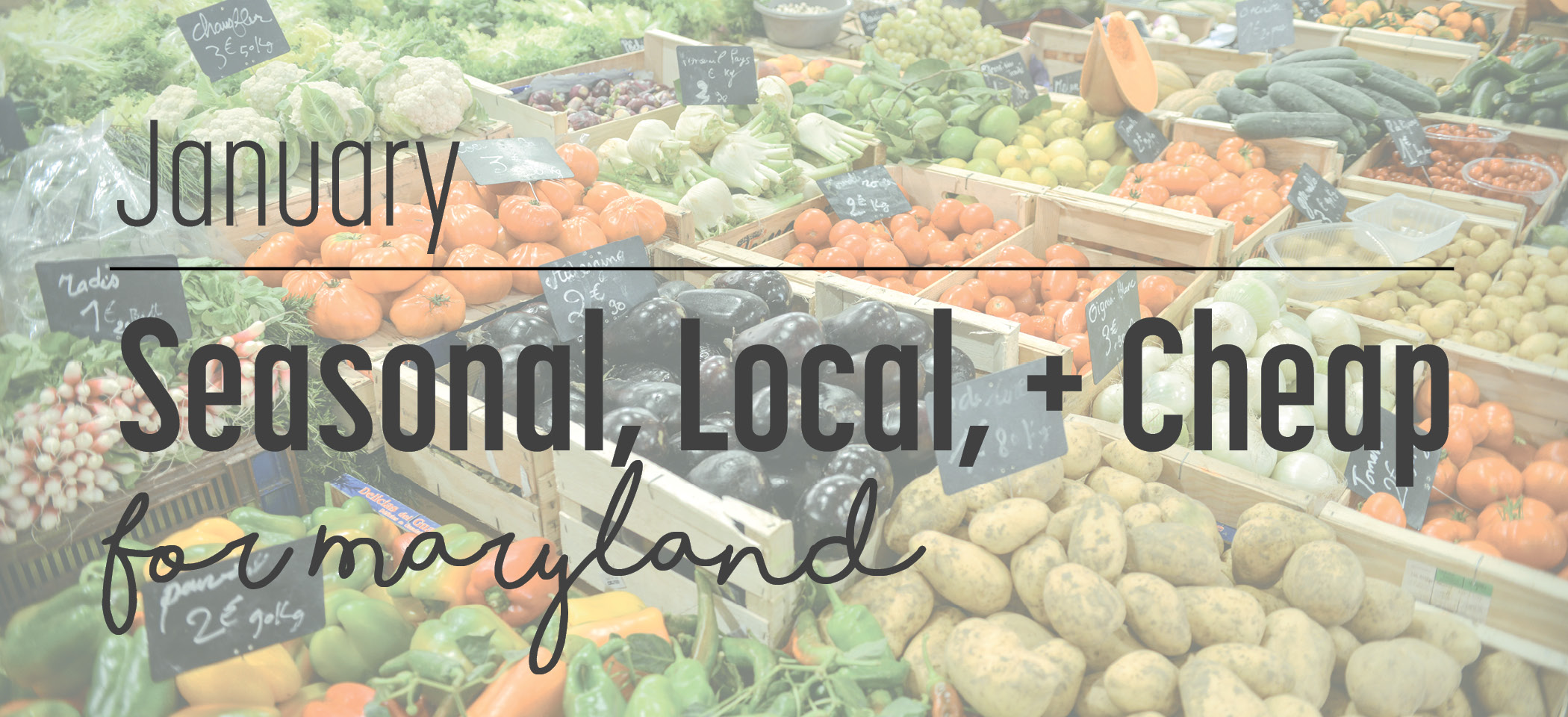It’s a new year! At Crunchy Vegan, we’re hoping to help you kick-off 2017 right and to live each month according to your own values. That’s why we’re introducing a new series: Seasonal, Local, Cheap! This monthly series will demonstrate how you can buy food that’s local and in season.
January
It’s the new year, and you’ve set your resolutions. Most of us strive to be healthier—to eat healthier. Rather than fret over what to cut out of your diet, it feels better to think about what you’re going to eat more of instead. Eating more fresh, whole foods is a great place to start.
We’re excited to begin this series with the beginning of the year. Buying local/seasonal food in the winter months can be a challenge. Fortunately, it’s convenient and affordable to buy local produce year-round—you may just need to get a little creative. With a focus on Maryland, the chart below highlights produce that is in season or available beyond its natural season thanks to cold storage or greenhouse cultivation.

In Season, but Not Local:
Particularly in these colder months, eating seasonal and local might offer slim-pickings. Now, you could stick exclusively to root vegetables, but don’t beat yourself up if you want to expand your palate. You can still feel good eating these non-Maryland, but in-season foods:
Vegetables:
- Arugula
- Baby Greens
- Beets
- Bok choy
- Broccoli
- Broccoli rabe
- Brussels Sprouts
- Cabbage
- Cardoons
- Cauliflower
- Celery*
- Chard
- Chicory
- Collard Greens
- Cress
- Dandelion Greens
- Endive
- Fava Greens
- Fennel
- Herbs (Parsley, Cilantro)
- Kale
- Kohlrabi
- Lambsquarters
- Leeks
- Microgreens
- Mustard Greens
- Nettles
- Okra
- Orach
- Parsnips
- Pea Shoots
- Potatoes*
- Radishes
- Rutabagas
- Scallions
- Shallots*
- Spinach
- Squash, Winter*
- Sunchokes
- Sweet Potatoes*
- Taro root
- Tatsoi
Fruits/Nuts/Seeds:
- Almonds*
- Apples*
- Asian Pears*
- Avocados
- Cherimoyas
- Citron
- Dates*
- Grapefruit
- Kiwi*
- Kumquats
- Lemons
- Limes
- Mandarins
- Olives
- Oranges
- Pears*
- Pecans*
- Persimmons*
- Pistachios*
- Pomelos
- Walnuts*
* Can be found at the market, but not within its natural growing season.
Where to Buy
Now, you may be wondering how you can buy local in the winter. Don’t farmers markets close at the end of the warmer months? Not necessarily! While some markets will close up shop in the fall, there are plenty that remain open throughout the year. Have a look at the Maryland Winter’s Farmers Market Guide from the Maryland Department of Agriculture. One of our favorite Baltimore markets is the year-round 32nd Street Farmers Market in Waverly!
Additionally, it’s not uncommon for grocery stores, particularly health food stores, to carry and label produce grown locally (typically, ‘local’ to a grocer includes a multi-state region—at least it does from our experience in Maryland). And remember, buying food while it’s in season can be a lot cheaper! You might also be surprised to find out that wholesale stores (e.g., BJs, Costco, or SAM’s Club, etc.) will shift their stock depending on the season! (Bulk pomegranates? Yes please!)
CSAs
For this series, we’re partnering with (vegan) farmer Emma Jagoz from Moon Valley Farm in Baltimore County. She’s providing some great information about local food. And you’ll be happy to know that sign-up for the 2017 season community supported agriculture (CSA) share from Moon Valley is now open! There are a number of share types (so you can select one to suit your needs) as well as various pick-up locations (so you can find one that’s conveniently located). So, you can either pay online via PayPal, or pay by check along with this completed Member Agreement Form and mailing it to:
Moon Valley Farm, 1124 Greenway Road, Cockeysville, MD 21030
Pairing Tips
Don’t forget that eating seasonally doesn’t limit you to just those foods that are being harvested that month. You can complement and complete your meals with grains, pastas, breads, dried goods, canned goods, and jarred foods, or with frozen foods as well. We highly recommend saving money by purchasing these goods in bulk, or preserving and storing foods from earlier seasons yourself. And of course season your food with dried spices and sauces you’ve either purchased or made throughout the year!
![IMG_0959[1].JPG](http://www.crunchy-vegan.com/2017/01/img_09591.jpg)
Suggested Recipes
So what are some comforting, delicious, and wholesome meals you can prepare this January? We’ve selected a handful of recipes you might want to try. Most or all of the ingredients are typically in-season this time of year, with the occasional out-of-season addition. We encourage you to play around with the recipes yourself, and if you think you can make it 100% local and 100% in-season, we would love to see what you cook up! Here are some ideas:
- Apple Cucumber Waldorf Salad | The Vegan Chef
- Carrot Soup with Caramelized Onions | The Tomato Tart
- Mushroom and Leek Risotto | The Minimalist Baker
- Creamy Mashed Turnips & Parsnips | Food.com
- Homemade Apple Cinnamon Pie | Veganosity
Go Forth, January!
Well there you have it! We hope we’ve given you some resources and ideas to go out there and eat locally, eat seasonally, and eat deliciously! Remember to share your thoughts, comments, and experiences in the comments!

Resources:
- Moon Valley Farm (Maryland CSA)
- Seasonal Foods Guide
- Cookie + Kate January Produce Guide
- CUESA Seasonality Chart – Vegetables
- CUESA Seasonality Chart – Fruit
- Shari’s Berries Fruit Seasons Chart
- Calendar of Maryland Harvests
- Pick Your Own | Maryland Harvest Calendar
- Maryland Seasonal Fruits & Vegetables
- Maryland Fruit and Vegetable Seasonality Chart




Trackbacks/Pingbacks